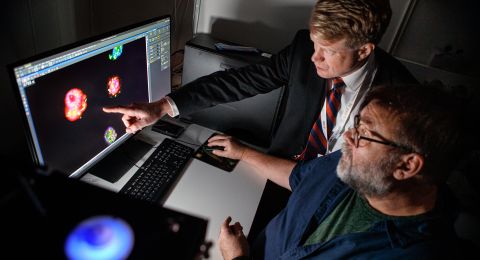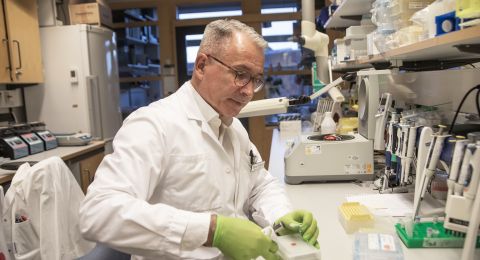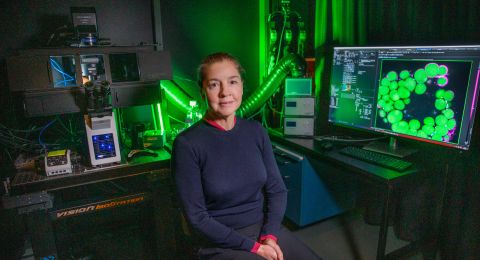Current cancer treatments, such as chemotherapy, are effective, but they come with drawbacks. They risk damaging healthy tissue and cause distressing side-effects. Laura Baranello aims to develop new, tailored treatments that specifically target cancer cells while sparing the rest of the body.
Laura Baranello
PhD in Cell and Molecular Medicine
Wallenberg Academy Fellow, grant extended 2022
Institution:
Karolinska Institutet
Research field:
Mapping the enzyme topoisomerase – knowledge that could lead to gentler cancer treatments.
Baranello, based at Karolinska Institutet, has spent many years studying the enzyme topoisomerase, a common target for several forms of chemotherapy.
For the human body to function, our cells must continuously copy and read their genetic material, the DNA. Topoisomerases play a crucial role in the process by which the DNA is replicated prior to cell division, and in transcription, by which genes are copied to generate proteins.
Topoisomerases help relieve the tension arising as the DNA helix unwinds to be copied or read.
The DNA molecule can be compared to an old-fashioned coiled telephone cord, and must be straightened before it can be properly read. As the DNA helix unwinds, a surplus of twists forms, resembling tight knots in a thread. Topoisomerase then cuts the DNA strand, rotates it, and reattaches it to allow replication and transcription to continue smoothly.
Several cancer drugs target the topoisomerases. This is because cancer cells often multiply very quickly and are therefore highly dependent on efficient topoisomerases. The growth of cancer cells can be slowed or stopped by inhibiting these enzymes.
The problem is that healthy cells that divide rapidly – such as those in the bone marrow and intestines – are also affected. This leads to side-effects such as nausea and a weakened immune system.
“I have seen firsthand how tough these side-effects are on patients,” says Baranello. “It motivates me to find better, more targeted methods.”
She wants to find ways to target topoisomerases that primarily affect cancer cells while sparing healthy ones.
“To achieve this, we must understand every molecular detail of the topoisomerases – the proteins they interact with and the steps in the process that can be turned off or weakened.”
Discovery of a “gas pedal”
Research is currently under way to understand the fundamental mechanisms. A few years ago, Baranello made an important discovery. She found that MYC, a protein involved in about 70 percent of human cancers, binds the topoisomerases and forms a protein complex. Within the complex, MYC increases the topoisomerase activity, causing tumor cells to grow faster.
“MYC acts as a gas pedal for the cancer cell by binding to DNA and increasing the expression of genes needed for growth.”
I never tire of basic research – there’s always something new to learn. That’s its great appeal.
When MYC starts the cell’s motor, it simultaneously promotes topoisomerases to work more efficiently. Baranello’s research team has shown that MYC can form a protein complex with two topoisomerases, making DNA replication and transcription even smoother. In a cancer cell, this combination has a dangerous turbo effect.
But this protein complex could also be a perfect target for new drugs. If the interaction between the “gas pedal” MYC and topoisomerases can be blocked, growth can be slowed.
“This would allow us to be more precise, without having to destroy topoisomerase activity throughout the body.”
New drugs
New drugs could eventually be developed. One idea is to design small molecules that interfere with MYC’s contact with topoisomerases or with topoisomerases activity while in the complex with MYC. Another is to create peptides that mask the part of the proteins where they meet.
However, all this requires detailed knowledge of fundamental mechanisms. Many questions remain: Which parts of the proteins latch on to each other? When, where and how fast does this occur in the cell? This requires painstaking basic research.
The researchers are using sequencing methods to read DNA and RNA on a large scale. These experiments help locate where knots in the genetic material tend to form, allowing scientists to predict where topoisomerases play their most crucial role. These methods also allow researchers to pinpoint the specific sites on DNA where the topoisomerase-MYC complex forms.
Additionally, advanced microscopy is being used to track individual molecules in living cells. This approach provides valuable insights into how quickly and efficiently enzymes work and how MYC impacts their behavior and movements.
As part of the basic research, Baranello is also studying how MYC and topoisomerase behave in more normal situations. One example is in the immune system’s B and T cells, where MYC also plays a key role. In collaboration with immunologist Lisa Westerberg at Karolinska Institutet, she is investigating how the complex affects immune cell development and whether disrupting the interaction between MYC and topoisomerase could pose risks to the immune system.
Moving to Sweden
Baranello began her career in Italy and spent many years working in the United States. When she received the Wallenberg Academy Fellow grant, she chose to move to Sweden.
“It’s an attractive research grant that gives me the freedom and the flexibility to test new ideas that could lead to major breakthroughs.”
Baranello hopes her research will eventually pave the way for improved quality of life for cancer patients.
“It is always tricky to promise exact timelines, but in the best case, we could see new drug candidates within five to ten years.”
Text Nils Johan Tjärnlund
Translation Maxwell Arding
Photo Magnus Bergström






